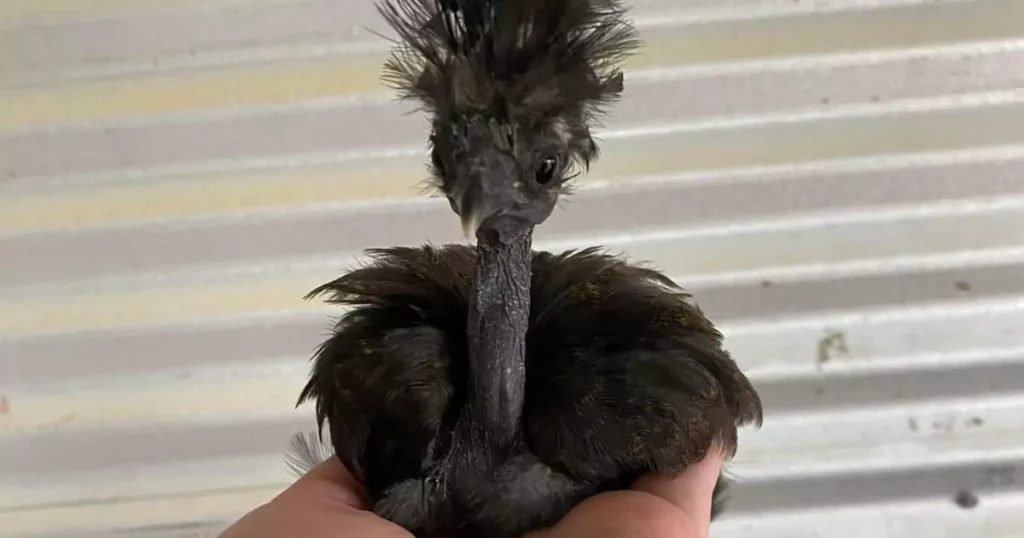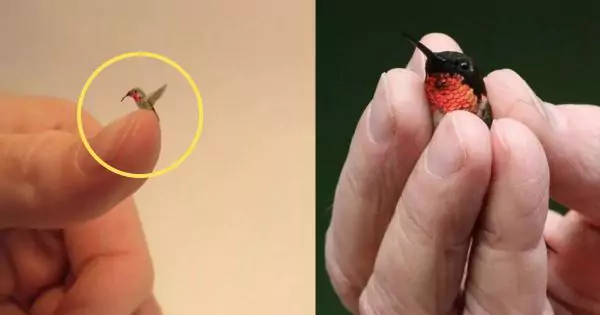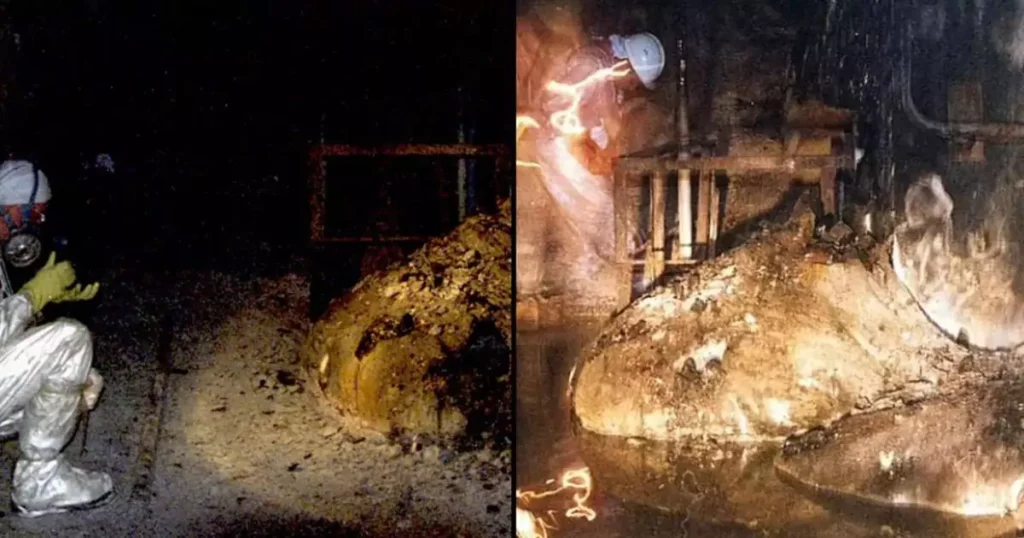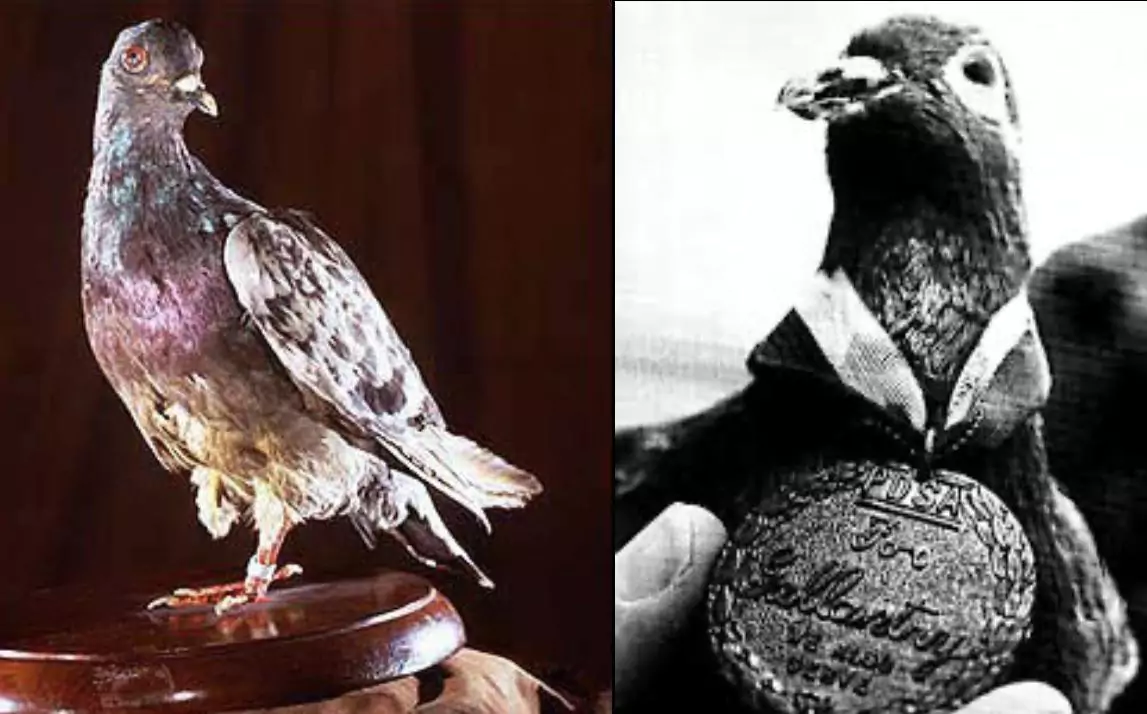
Cher Ami, a brave homing pigeon in World War I, is a hero not many know about. This bird’s story is full of bravery and shows how important animals were in the war. World War I was a time when sending messages was hard, especially across places with lots of enemies. That’s where homing pigeons, like Cher Ami, became very important.
These pigeons had a special skill – they could find their way home over long distances and were fast. Because of this, they were used a lot in the war to carry important messages when other ways of talking, like phones or radios, didn’t work or were too risky.
Cher Ami wasn’t just any pigeon. This bird did something amazing. In one of the toughest parts of World War I, the Meuse-Argonne Offensive, Cher Ami helped save nearly 200 soldiers. They were called the “Lost Battalion” and were in big trouble. But thanks to Cher Ami, they were saved.
This story isn’t just about a pigeon. It’s about the big role animals played in the war and how they saved lives. In this article, we will talk more about Cher Ami, how homing pigeons helped in World War I, and the big difference they made in one of the scariest times of the war.
The Role of Homing Pigeons in WWI
During World War I, communication was a big challenge. With no modern tech like we have today, soldiers had to rely on simpler ways to send messages. This is where homing pigeons played a huge part. These birds were special because they could fly long distances to carry important news from one place to another quickly and safely.
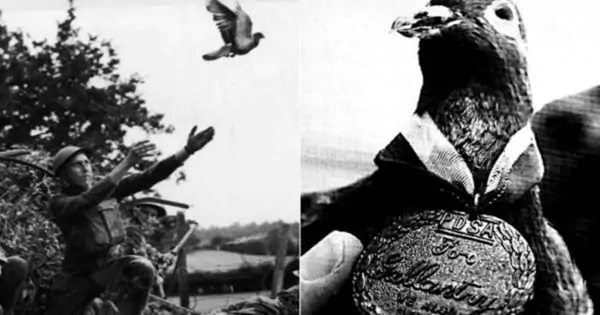
Why Homing Pigeons?
Homing pigeons were like the text messages of their day. They were fast, reliable, and could travel where no man could easily go. These birds had a natural ability to find their way home over long, challenging journeys. Even if they were released far away, they would fly back to their home loft with the message tied to their leg.
Soldiers used these pigeons to send updates and important info from the front lines back to their leaders. This was super helpful, especially when radios or telephones were broken or not safe to use because of enemy spying.
Training and Use in the War
Training these pigeons was a big deal. They were taught to fly between specific locations and to handle long flights. In World War I, both sides used these pigeons, knowing that their messages had a better chance of getting through without being caught by the enemy.
One cool fact is that these pigeons weren’t just carrying any messages – sometimes, they carried life-saving info. They helped plan attacks, send help to wounded soldiers, and even save whole battalions from dangerous situations.
Pigeons vs. Other Communication Methods
Why not just use people or other ways to send messages? Well, during the war, it was really risky. Soldiers carrying messages could be caught or messages could get lost. Homing pigeons flew high and fast, making it hard for the enemy to stop them.
Also, technology back then wasn’t as good. Radios were big and not very reliable. Wires for telephones could be cut. So, pigeons were often the best choice, especially when secrecy and speed were needed.
Cher Ami and Other Famous Pigeons
Cher Ami wasn’t the only pigeon who did amazing things in the war, but definitely one of the most famous. These pigeons were heroes in their own right, and their stories show how crucial they were in WWI.
In this article, we’re focusing on Cher Ami’s incredible journey, but it’s good to remember that many pigeons played a vital role in the war, carrying countless messages that helped save lives.
Cher Ami’s Role in World War I
Cher Ami was not just any pigeon; this bird was a real hero during World War I. Let’s explore how Cher Ami stood out and became famous for bravery and dedication.
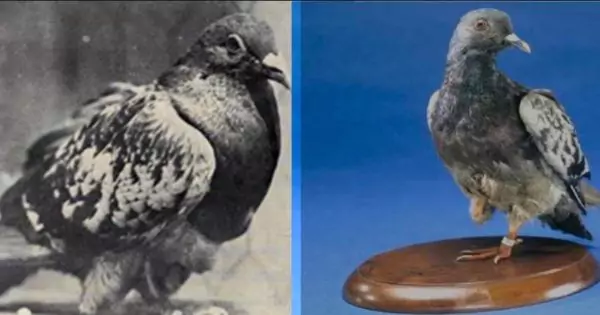
Cher Ami’s Training and Early Missions
Like other homing pigeons, Cher Ami underwent special training. This training made sure that the bird could fly long distances and find its way back, even from places it had never been before. The U.S. Army Signal Corps, who looked after pigeons like Cher Ami, made sure these birds were ready for tough missions.
Cher Ami started as one among many pigeons used by the army. These pigeons carried lots of messages, often flying through dangerous areas where soldiers couldn’t go. Cher Ami quickly proved to be reliable and fast, becoming a favorite for important missions.
A Special Pigeon for a Critical Role
What made Cher Ami special? It was not just about flying; it was about being brave and determined. War zones are scary, with loud noises, guns, and many dangers. Many pigeons would get scared or hurt, but Cher Ami kept going, flying through tough conditions to deliver messages.
Cher Ami became known for being able to handle even the most difficult tasks. When other forms of communication failed, the army knew they could rely on this brave pigeon to get the message through.
More Than Just Delivering Messages
Cher Ami’s role went beyond just carrying notes. This pigeon was a lifeline for soldiers. In times of war, quick and accurate information can save lives, and that’s exactly what Cher Ami provided. Whether it was a call for supplies, a report of enemy positions, or a cry for help, Cher Ami delivered these messages with incredible speed and accuracy.
One of the most remarkable things about Cher Ami was the trust the soldiers put in this bird. Knowing that a tiny pigeon could make such a big difference in a huge war was something special. It shows how important animals, not just people, were in history and in times of conflict.
Meuse-Argonne Offensive and the “Lost Battalion”
The Meuse-Argonne Offensive, a major part of World War I, is where Cher Ami’s most famous mission took place. This was a big battle, and in it, a group of American soldiers known as the “Lost Battalion” got into serious trouble. Let’s look at what happened and how Cher Ami became a hero.
The Battle and the Lost Battalion
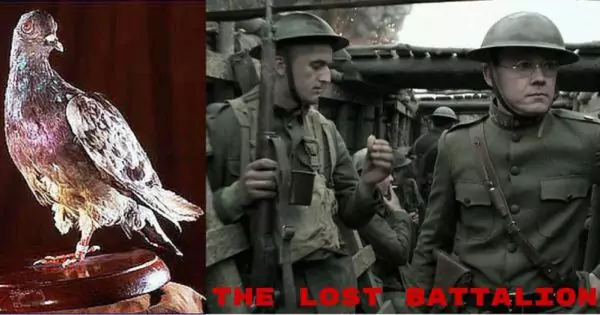
In October 1918, during the Meuse-Argonne Offensive, the U.S. Army’s 77th Division faced a tough fight. This division included a group of over 500 soldiers who advanced deep into the Argonne Forest. But things didn’t go as planned. They got cut off from the rest of their army and surrounded by German troops. This group was nicknamed the “Lost Battalion” because they were isolated and couldn’t be reached easily.
The situation was dire. They were low on food, water, and ammunition. Even worse, they started getting hit by shells from their own side, who didn’t know exactly where they were. They needed to send a message back to their commanders to tell them their location and stop the friendly fire.
Communication Challenges
In such a difficult situation, communication was key. But how could they send a message? They couldn’t just walk out of the forest – the enemy was all around. Radios and wires were not working. This is where homing pigeons, like Cher Ami, came in. They were the only way to get a message out.
The battalion had several pigeons with them, and they started sending messages. But one by one, these pigeons were shot down or got lost. The situation was getting worse by the minute.
Cher Ami’s Crucial Mission
Finally, it was Cher Ami’s turn. By then, the battalion was really desperate. They had seen other pigeons fail, and they knew this might be their last chance. So they wrote a quick note, explaining their dangerous situation and needing help urgently. This message was tied to Cher Ami, and the bird was released, carrying the hopes of all those soldiers.
Imagine this scene: a tiny bird flying out into a sky full of danger. Cher Ami had to dodge bullets, navigate through the forest, and cover 25 miles to deliver this critical message. It was a race against time, with lives hanging in the balance.
The Critical Message and Cher Ami’s Heroic Act
Cher Ami’s mission during the Meuse-Argonne Offensive was more than just a regular message delivery. It was a matter of life and death for the soldiers of the “Lost Battalion.” This section delves into the critical message Cher Ami carried and the extraordinary bravery displayed during this perilous journey.
The Life-Saving Message
The message tied to Cher Ami was short but urgent. It read, “We are along the road parallel to 276.4. Our own artillery is dropping a barrage directly on us. For heaven’s sake, stop it.” This note was a desperate plea to stop the friendly fire that was mistakenly targeting the battalion’s position in the forest.
Cher Ami’s Daunting Flight
After the message was secured, Cher Ami was released into the sky. The bird soared into the air, heading straight into the danger zone. The journey back to headquarters was about 25 miles – a challenging distance under normal conditions, but even more so in a war zone. The forest was filled with enemy soldiers, and the skies were not safe either, with bullets whizzing through the air.
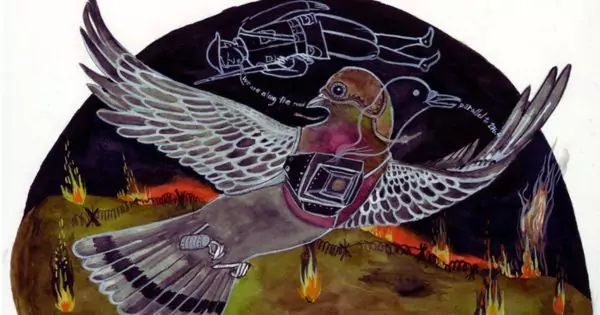
Cher Ami flew with incredible speed and determination, navigating the hazardous terrain. The bird faced numerous threats, but its focus was unshakable. This was not just any mission; it was a race against time to save the lives of hundreds of soldiers.
A Display of Extraordinary Courage
Tragically, during the flight, Cher Ami was shot and injured. Despite a wound to the breast, a damaged leg, and losing the sight in one eye, the pigeon continued its mission. This act of resilience and courage is what sets Cher Ami apart as a true war hero.
Against all odds, Cher Ami reached the division headquarters. The journey took only 25 minutes, but for the soldiers awaiting rescue, it must have felt like an eternity. The message was received in time, and the artillery fire was stopped, saving the lives of nearly 200 men.
Impact of the Heroic Act
Cher Ami’s successful delivery of this critical message highlights the pivotal role of homing pigeons in wartime communication. It’s a vivid example of how a small, seemingly insignificant creature can make a monumental difference in the course of events.
The Aftermath and Impact
The successful delivery of the critical message by Cher Ami had immediate and significant consequences. This act of bravery not only highlighted the vital role of homing pigeons in war but also underscored the extraordinary circumstances under which these animals operated.
Saving the “Lost Battalion”
Once Cher Ami’s message was received, the coordinates of the “Lost Battalion” were quickly identified, and the friendly fire that had been raining down on them ceased. This immediate action prevented further casualties and paved the way for a rescue operation. Ultimately, about 194 men of the battalion were saved. Without Cher Ami’s brave flight, the fate of these soldiers could have been drastically different.
Recognizing Cher Ami’s Bravery
Cher Ami’s heroic act did not go unnoticed. For the bravery and service shown, Cher Ami was awarded the French Croix de Guerre with Palm, one of France’s highest military honors. This recognition was not just for delivering a message, but for doing so under extreme conditions and at great personal risk.
Impact on War Communications and Legacy
Cher Ami’s story brought to light the crucial role that homing pigeons played in WWI. These birds were not just messengers; they were lifelines, especially in situations where no other form of communication was feasible. The reliability, speed, and courage of pigeons like Cher Ami proved to be indispensable in the war efforts.
The legacy of Cher Ami goes beyond the individual bird. It’s a story that symbolizes the broader contributions of animals in military operations. The bravery shown by Cher Ami served as an inspiration and a reminder of the diverse and critical roles animals have played throughout history in human conflicts.
Cher Ami’s Influence Beyond the War
The story of Cher Ami resonates beyond military history. It has become a symbol of determination, resilience, and the powerful bond between humans and animals. Cher Ami’s tale is often shared in educational contexts and remains a poignant example of the unexpected heroes in war.
Awards, Legacy, and Posthumous Recognition
Cher Ami’s extraordinary service in World War I has been honored and remembered in various ways, reflecting the profound impact of this courageous pigeon.
Awarded for Bravery
Cher Ami was awarded the French Croix de Guerre with Palm, a prestigious military honor, recognizing acts of heroism. This award is significant because it’s not often that animals are officially recognized for their contributions in war. Cher Ami’s recognition was a testament to the critical role the pigeon played in saving the lives of the soldiers of the “Lost Battalion.”
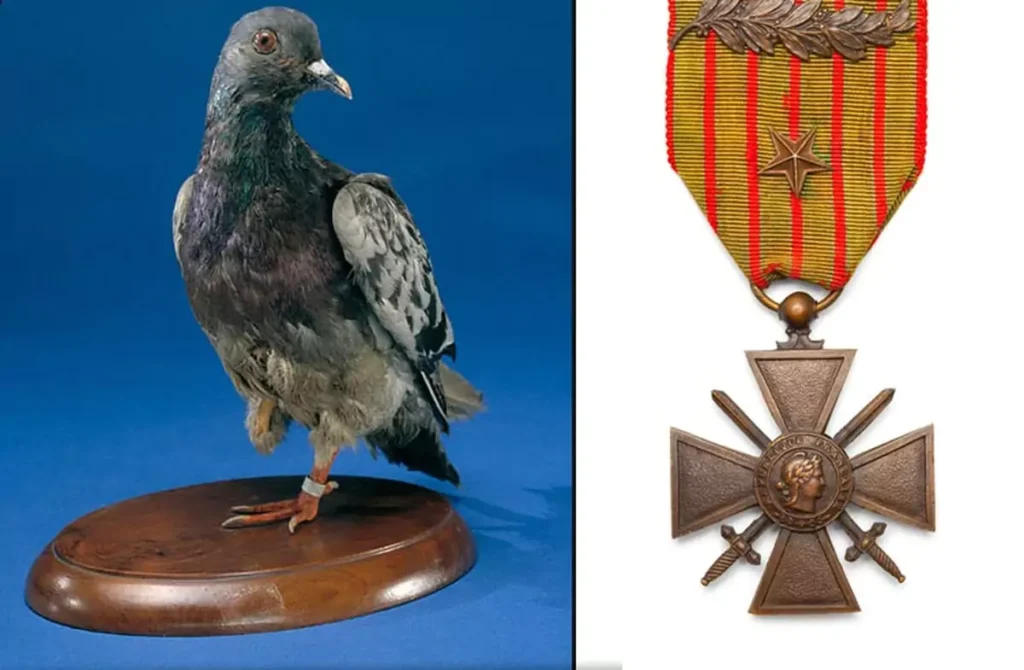
A Lasting Legacy
The story of Cher Ami has become a part of military and animal history. It serves as a powerful reminder of the valiant roles animals have played in human conflicts. Cher Ami’s bravery, and that of other animals in service, has inspired books, documentaries, and educational materials, highlighting the diverse roles animals play in human history.
Preservation and Display
In honor of Cher Ami’s service and sacrifice, the bird’s body was preserved after its death. Today, Cher Ami is displayed at the Smithsonian National Museum of American History. This display is not just about showcasing a hero from the past; it’s about teaching future generations the important roles that animals have played in shaping history.
Symbol of Animal Contribution in War
Cher Ami’s story goes beyond individual achievement. It symbolizes the broader contributions of carrier pigeons and other animals in military service. The pigeon’s courage under dire circumstances is a poignant reminder of the often-overlooked sacrifices made by animals in war.
Cher Ami’s Tragic Death
After losing a leg, an eye and having been shot through the chest, Cher Ami, a WW1 homing pigeon, was sent from behind enemy lines. After reaching her destination she passed on the message that saved 194 men. Medics saved her and fitted her with a carved wooden leg. She died a year later, a hero.
Injuries Sustained During the Mission
While delivering the life-saving message, Cher Ami was shot, suffering severe injuries. The brave bird was wounded in the breast, had a leg hanging only by a tendon, and lost sight in one eye. Despite these grave injuries, Cher Ami continued the mission, a testament to the bird’s resilience and determination.
Medical Care and Efforts to Save Cher Ami
Upon completion of the mission, Cher Ami received medical care from the army veterinarians. Efforts were made to heal the wounds, and a wooden leg was even crafted to replace the injured one. These measures underscore the high regard in which Cher Ami was held and the earnest desire to save the bird that had saved so many soldiers.
The Toll of Injuries and Cher Ami’s Passing
Despite the care and attention, the extent of Cher Ami’s injuries proved too severe. About six months after the heroic mission, in 1919, Cher Ami succumbed to the wounds. This loss was felt not just by those who directly benefited from the bird’s bravery but also by many who heard the story of Cher Ami’s heroism.
Reflecting on the Sacrifices
Cher Ami’s death serves as a poignant reminder of the sacrifices made in times of war, extending beyond human soldiers to the animals that play crucial roles. The story of Cher Ami, while inspiring, also brings to light the often harsh and unforgiving realities of wartime service, regardless of being human or animal.
Whole Story Summary
Cher Ami’s story is a powerful testament to the extraordinary roles that animals have played in human conflicts. This remarkable homing pigeon not only highlights the bravery and sacrifice in times of war but also the diverse and crucial roles that animals can fulfill.
Cher Ami’s heroic flight during the Meuse-Argonne Offensive and the successful delivery of a critical message saved the lives of nearly 200 soldiers. This act of bravery earned Cher Ami not just military honors, but a lasting place in history. The bird’s story has been an inspiration, reminding us of the unassuming yet significant contributions of animals in shaping historical events.
While Cher Ami’s life ended tragically due to the injuries sustained in service, the legacy lives on. Displayed at the Smithsonian National Museum of American History, Cher Ami continues to educate and inspire future generations about the sacrifices and valor of animals in war.
Cher Ami’s story is not just about a single pigeon or a single act of bravery. It’s a broader narrative about resilience, dedication, and the profound impact animals have had in supporting human endeavors, particularly in times of conflict and need.

